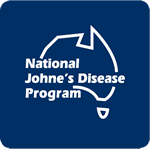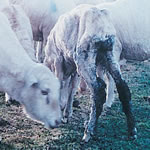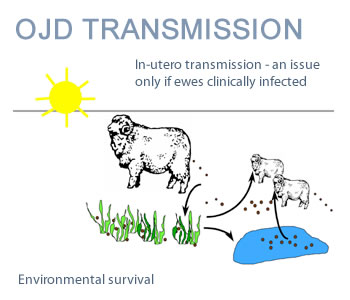Ovine Johne's disease (OJD)
What is OJD?
 Ovine Johne’s disease (OJD) is an incurable, infectious wasting disease of sheep that can result in significant economic losses on infected farms due to sheep deaths, and lost production in meat, lambs and wool.
Ovine Johne’s disease (OJD) is an incurable, infectious wasting disease of sheep that can result in significant economic losses on infected farms due to sheep deaths, and lost production in meat, lambs and wool.
OJD is caused by the sheep strain of bacterium Mycobacterium paratuberculosis, which leads to the intestinal wall slowly thickening, causing reduced absorption of nutrients from the intestine. This eventually leads to severe loss of condition – infected sheep can waste away and die.
The bacteria are passed in the manure of infected animals, contaminating pasture and water supplies and spreading infection to other susceptible sheep. Once a flock is endemically infected with OJD, it is difficult to eradicate.
What are the Signs of OJD?

An example of OJDOJD is often not diagnosed in a flock until a significant
proportion of the flock is already infected and deaths
are occurring.
There is often no sign for the first few years - that is why it is often referred to as a 'silent but costly disease'. Infected sheep can be shedding the bacteria in their manure for a considerable period (sometimes years) even though the flock still looks healthy, but they are contaminating the pasture and infecting other sheep.
The classic sign of the disease in a mob is a distinct 'tail', with sheep ranging in condition from good to very poor; then the sheep in the 'tail' start dying. The number of sheep in this 'tail' may be constant but is made up of different animals over time, insidiously eating away at flock numbers and profits.
The infected sheep continue to eat and drink normally until they are too weak to graze and eventually die. Scouring may occur, but is not a common feature of Johne's disease in sheep. In some large flocks, the number of deaths may only be appreciated when big discrepancies occur in counts of adult sheep.
When obvious OJD deaths are noticed, the disease is likely to be well established and it will take some years to get the situation under control, during which time deaths will continue. The best place to look for the disease is in two and three year olds, but sheep from weaners through to older adults can also die from the disease.
How is OJD Spread?
OJD usually enters a flock through the introduction of infected sheep (bought in or agisted) or stray animals (from infected neighbours).
Sheep manure and contaminated run-off can also spread the infection between farms once it has ‘seeded’ into an area.
The risk of spreading infection via natural waterways and floodplains is also present.
OJD bacteria are shed in huge numbers in the manure of infected sheep. Animals pick up the infection from contaminated pastures, water and teats. The bacteria can survive for many months in shaded environments.
Why Prevent OJD?
OJD infection can result in
significant economic losses
on infected farms due to sheep
deaths and lost production.
Owners of flocks that are infected with
OJD who undertake no appropriate
management measures will, over time,
experience heavy production losses
and deaths as the level of infection
within the flock increases. Annual
death rates in infected Australian sheep
flocks of up to 25% annually have been
seen and, in a self-replacing flock, the
lambing percentages can fall to an
unsustainable level.
In addition, OJD has a severe impact on the welfare of sheep as it is a disease that causes death through slow starvation.
About the Disease
in their manure without ever showing any obvious signs of the disease, although loss of production still occurs.
OJD has a long incubation period (the time from initial infection of the sheep until it shows signs of disease) and most infected sheep do not begin to show any signs of illness until after two years of age. From the onset of obvious signs of the disease, they start to rapidly lose condition and usually die within the next three to six months.
There is no cure or successful treatment available for infected sheep. Vaccination is a valuable tool in reducing mortalities and shedding of OJD bacteria, however it is not fully effective and shedding can still occur. Some vaccinated sheep in an infected flock are likely to be infectious.
What can you do to keep the disease out of your Flock?
This depends on how much OJD is in your district, but here are some basics tips:
- Only buy in or agist sheep with a high level of assurance provided by either the SheepMAP or from recent testing of a closed flock.
- Always ask for a signed Sheep Health Statement before you buy any sheep and only purchase sheep from reputable vendors whom you trust.
- Vaccinate your flock if there is a risk of OJD coming in from straying stock from neighbours, or if you are in a district with high prevalence, as the risk from ‘lateral spread’ is high. (Note: Vaccination alone does not give a high level of assurance as vaccinated sheep from infected flocks can still shed OJD bacteria.)
- Improve your flock’s resistance to disease through good nutrition and worm control.
- Where possible, use abattoir monitoring results from your adult sheep to monitor for infection.
- If you suspect that you may have OJD, ensure that you have cases investigated immediately and start vaccinating.
- The earlier you act, the smaller the impact of OJD on your business.
- Work with neighbours to minimise potential spread between farms and consider joining a Regional Biosecurity Group.
- Even if you are in a district with no known OJD, it is important to follow these guidelines and always be aware.
- Become familiar with the recommended practices for preventing and controlling OJD by visiting www.ojd.com.au.
What can you do if your flock is already infected?
The disease has proven difficult to
eradicate from infected properties.
Affected sheep producers need to
manage their flocks and properties
to reduce the overall on-farm
impact of the disease. Best practice
advice includes:
- Vaccinate all animals as lambs and only buy approved vaccinates.
- Humanely slaughter any sheep showing signs of OJD. This is important on welfare grounds and it also helps to reduce contamination of your land.
- Use the dung test (pooled faecal culture test) to identify and cull heavily shedding mobs.
- Where possible, use abattoir monitoring results from your adult sheep to monitor disease control.
- Improve your flock’s resistance to disease through good nutrition and worm control.
- Reduce exposure of young sheep to OJD by placing them on ‘clean’ pastures or those grazed by other species. Avoid placing young sheep on pastures recently grazed by unvaccinated adult ewes or wethers.
- Clean up contaminated pasture by:
- grazing with steers
- rotating with crops
- re-sowing pasture
- grazing with terminal lambs and selling them straight to slaughter.
- Avoid feeding on ground – go for troughs or automatic feeders.
- Fence off low areas or creeks where water may be contaminated.
- Consider changing your enterprise mix so that you are running fewer susceptible sheep.
- Become familiar with the recommended practices for controlling OJD by visiting www.ojd.com.au
More Information
 Downloads
Downloads
Contact
Animal Health Australia
Email: johnes@animalhealthaustralia.com.au
Phone: (02) 6232 5522
Fax: (02) 6232 5511
www.animalhealthaustralia.com.au